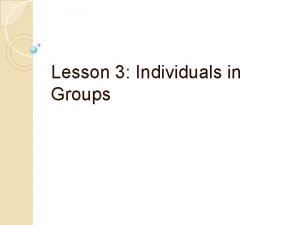Groups to Individuals Module 2 Steeves and Farr







- Slides: 7

Groups to Individuals Module 2 Steeves and Farr, UA, EEB Michod Lab

Evolution of Multicellularity - Molecules and cells have cooperated to make multicellular organisms - Benefits of multicellularity? - Increased size - Protection from predators - Buffering from environmental changes - Specialization of jobs or tasks - Greater efficiency due to specialization - New functions not available to single cells

From Simple to Complex Remember Chlamydomonas and Volvox? How does this group demonstrate cooperation?

Social Group Dynamics (The Genetics of ? ) - Social group formation looks a lot like the multilevel selection process at the cellular level - Compare the cells in a multicellular organism with: - your favorite sports team - your school demographics - local government - national government - your work place

Stages of group formation Multilevel Selection - Formation: increase in size, cooperation, specialization -Conflict and cheating - A new, “indivisible” organism is formed. Group Formation - Forming: meets, sets goals, tackles tasks, etc - Storming: competition for ideas, leadership, confrontation - Norming: agreement, trust, participation - Performing: stuff gets done well, efficiently, independently. Tuckman, B. W. 1965. Psychological Bulletin 63: 384 -399.

Conflict is ABSOLUTELY going to happen in groups, assuming: 1. ) members feel vested and “safe” 2. ) have the time for it to evolve 3. ) The stages are not always discrete: there can be some overlap, switching back and forth between “stages. ” Some groups get through it faster than others, and group facilitation is one key factor in how that happens. Tuckman, B. W. 1965. Psychological Bulletin 63: 384 -399.

Making the Point - Break into small groups: 5 or 6 per group. - Each group will be assigned a task to perform. - Have one observer (a “shill”) in each group take notes and relate it to the stages in the process. - Be prepared to discuss similarities between group formation and multilevel selection. Tuckman, B. W. 1965. Psychological Bulletin 63: 384 -399.
 Individuals groups and institutions
Individuals groups and institutions The activities that independent individuals groups
The activities that independent individuals groups How are ethnic groups and religious groups related
How are ethnic groups and religious groups related C device module module 1
C device module module 1 Risk management for enterprises and individuals
Risk management for enterprises and individuals Johannes volkelt empathy theory
Johannes volkelt empathy theory Serving individuals and families
Serving individuals and families Serving individuals and families
Serving individuals and families













